Don't wanna be here? Send us removal request.
Text

4-steps to master spring framework | Spring Online Training
Unlock your potential in software development with our 4 Steps to Master the Spring Framework course! This comprehensive training covers core concepts, advanced techniques, and best practices. You'll gain hands-on experience through real-world projects and expert guidance, empowering you to build robust applications. Join us for Spring Online Training today!
0 notes
Text

The 6 key components of a CI/CD pipeline | DevOps Online Course
The 6 key components of a CI/CD pipeline include version control, continuous integration, automated testing, continuous delivery, continuous deployment, and monitoring. Learn to master these components in our DevOps Online Course with hands-on projects and real-time scenarios!
0 notes
Text
Master DevOps: Your Complete Guide and Roadmap | DevOps Online Training

Introduction to DevOps
In today's rapidly evolving technological landscape, the need for streamlined and efficient software development practices has never been greater. Enter DevOps—a culture, philosophy, and set of practices that bring development (Dev) and operations (Ops) together to improve collaboration, integration, and automation throughout the software development lifecycle. DevOps is not just a buzzword; it's a transformative approach that enables organizations to deliver high-quality software faster and more reliably. If you're looking to build a career in this field, DevOps Online Training is your gateway to mastering the skills required to excel in this domain.
What is DevOps?
DevOps is a combination of practices, tools, and cultural philosophies designed to increase an organization's ability to deliver applications and services at high velocity. By breaking down the traditional silos between development and operations teams, DevOps fosters a culture of collaboration, where both teams work together throughout the entire software development lifecycle. This collaboration leads to faster development, more frequent deployment of updates, and higher overall software quality.
At its core, DevOps emphasizes automation, continuous integration, continuous delivery (CI/CD), and monitoring. The goal is to minimize manual intervention, reduce errors, and improve the efficiency of software development and deployment. Through DevOps Online Training, you can learn how to implement these practices in real-world scenarios, making you an invaluable asset to any tech organization.
How DevOps Works
DevOps is built on a set of principles and practices that enable organizations to build, test, and deploy software rapidly and efficiently. Here's how DevOps works in practice:
1. Continuous Integration and Continuous Deployment (CI/CD)
Continuous Integration (CI) is the practice of merging code changes frequently, often multiple times a day, into a shared repository. Automated testing is then conducted to identify and resolve issues early in the development process. Continuous Deployment (CD) takes this a step further by automatically deploying code changes to production after passing the CI pipeline. Together, CI/CD reduces the time between writing code and delivering it to customers, ensuring that software updates are released frequently and reliably.
2. Automation
Automation is a critical component of DevOps. From building and testing code to deploying and monitoring applications, automation helps streamline the entire software development lifecycle. By automating repetitive tasks, teams can focus on more strategic activities, such as optimizing code and improving system performance. Automation tools like Jenkins, Ansible, and Puppet are commonly used in DevOps to create efficient, repeatable processes.
3. Infrastructure as Code (IaC)
Infrastructure as Code (IaC) is the practice of managing and provisioning computing infrastructure through machine-readable scripts rather than manual processes. This approach allows teams to automate the setup and configuration of environments, ensuring consistency across development, testing, and production stages. Tools like Terraform and AWS CloudFormation are popular choices for implementing IaC.
4. Monitoring and Logging
Effective monitoring and logging are essential to maintaining the health and performance of applications in a DevOps environment. By continuously monitoring systems and capturing logs, teams can identify and resolve issues before they impact end-users. Tools like Prometheus, Grafana, and ELK Stack are widely used for monitoring and logging in DevOps.
5. Collaboration and Communication
DevOps is as much about culture as it is about technology. A key aspect of DevOps is fostering a culture of collaboration and communication between development, operations, and other stakeholders. This collaboration ensures that everyone is aligned with the project's goals and that issues are addressed quickly. Tools like Slack, Microsoft Teams, and Jira facilitate communication and collaboration in a DevOps environment.
6. Security in DevOps (DevSecOps)
As security becomes increasingly important in software development, DevOps practices have evolved to include security as a core component. DevSecOps integrates security into every stage of the software development lifecycle, ensuring that security vulnerabilities are identified and addressed early in the process. By adopting DevSecOps practices, organizations can build more secure applications without compromising on speed and agility.
The Roadmap to Becoming a DevOps Engineer
Becoming a DevOps engineer requires a combination of technical skills, practical experience, and a deep understanding of DevOps principles. Here's a step-by-step roadmap to guide you on your journey:
1. Understand the Basics of DevOps
Before diving into specific tools and technologies, it's important to understand the fundamental principles of DevOps. Learn about the core concepts of CI/CD, automation, IaC, and monitoring. DevOps Online Training can provide you with a solid foundation in these areas, helping you grasp the essential elements of DevOps.
2. Gain Proficiency in Programming and Scripting
A strong foundation in programming and scripting is essential for a DevOps engineer. Start by learning a programming language like Python, Ruby, or Go, as well as scripting languages like Bash or PowerShell. These skills will enable you to automate tasks, write custom scripts, and work with various DevOps tools.
3. Master Version Control Systems
Version control systems (VCS) like Git are critical to DevOps practices. Learn how to use Git for version control, branching, and merging code. Understand how to collaborate with other developers using GitHub, GitLab, or Bitbucket. Version control is a fundamental skill that every DevOps engineer must possess.
4. Get Hands-On with CI/CD Tools
CI/CD is at the heart of DevOps, so gaining hands-on experience with CI/CD tools is crucial. Learn how to set up and configure Jenkins, CircleCI, or Travis CI to automate the build, test, and deployment processes. DevOps Online Training often includes practical labs and exercises that allow you to practice using these tools in real-world scenarios.
5. Learn About Infrastructure as Code (IaC)
IaC is a key practice in DevOps, enabling teams to manage and provision infrastructure programmatically. Familiarize yourself with IaC tools like Terraform, AWS CloudFormation, and Ansible. Learn how to write scripts that automate the creation and configuration of infrastructure, ensuring consistency across environments.
6. Develop Cloud Computing Skills
Cloud computing is an integral part of DevOps, as it provides the scalability and flexibility needed for modern software development. Gain proficiency in cloud platforms like AWS, Azure, or Google Cloud. Learn how to deploy applications to the cloud, manage cloud resources, and work with cloud-based DevOps tools.
7. Enhance Your Automation Skills
Automation is a cornerstone of DevOps, so it's essential to master automation tools and techniques. Learn how to automate tasks using tools like Jenkins, Puppet, and Chef. Understand how to create automated workflows that integrate with other DevOps tools and processes.
8. Learn About Monitoring and Logging
Effective monitoring and logging are crucial for maintaining the health of applications in a DevOps environment. Familiarize yourself with monitoring tools like Prometheus and Grafana, as well as logging tools like the ELK Stack. Learn how to set up monitoring dashboards, create alerts, and analyze logs to identify and resolve issues.
9. Embrace DevSecOps Practices
Security is a critical aspect of DevOps, and understanding DevSecOps practices is essential for a successful career in this field. Learn how to integrate security into the CI/CD pipeline, conduct security testing, and implement security best practices throughout the software development lifecycle.
10. Gain Practical Experience
Theory alone is not enough to become a proficient DevOps engineer. Hands-on experience is crucial. Work on real-world projects, contribute to open-source DevOps projects, or participate in internships. Practical experience will help you apply the skills you've learned and build a portfolio that showcases your expertise.
11. Obtain DevOps Certifications
Certifications can validate your skills and make you stand out in the job market. Consider obtaining certifications like AWS Certified DevOps Engineer, Google Cloud DevOps Engineer, or Microsoft Certified: Azure DevOps Engineer Expert. These certifications demonstrate your proficiency in DevOps practices and tools.
12. Stay Updated with Industry Trends
The field of DevOps is constantly evolving, with new tools and practices emerging regularly. Stay updated with industry trends by reading blogs, attending conferences, and participating in online communities. DevOps Online Training programs often include updates on the latest trends and tools in the industry.
13. Build a Strong Professional Network
Networking is important in any career, and DevOps is no exception. Join DevOps communities, attend meetups, and connect with other professionals in the field. Building a strong network can lead to job opportunities, collaborations, and valuable insights.
14. Prepare for DevOps Interviews
As you near the end of your learning journey, it's time to prepare for DevOps interviews. Practice common DevOps interview questions, participate in mock interviews, and review your projects and experiences. DevOps Online Training programs often include interview preparation sessions to help you succeed in landing your first DevOps job.
Conclusion
DevOps is a powerful approach that has revolutionized the way software is developed, tested, and deployed. By fostering collaboration between development and operations teams and leveraging automation, CI/CD, and cloud computing, DevOps enables organizations to deliver high-quality software at a rapid pace. Whether you're just starting your career or looking to transition into the field, DevOps Online Training can provide you with the skills and knowledge needed to succeed as a DevOps engineer.
By following the roadmap outlined in this article, you can develop the technical expertise, practical experience, and industry knowledge required to excel in DevOps. Remember to stay updated with the latest trends, build a strong network, and continuously improve your skills.
#devops#devopsonlinetraining#devops engineer#DevOps Roadmap#web development#development#software#Continuous Integration#Continuous Deployment#Cloud Computing#Automation#Software Development#IT Training#cicd#it training institute#it training courses#it training classes
0 notes
Text
DevOps for Machine Learning and Artificial Intelligence

In today's tech world, DevOps is known for its ability to streamline development and operations. However, when it comes to machine learning (ML) and artificial intelligence (AI), traditional DevOps practices encounter unique challenges. Enter MLOps—a specialized approach that bridges the gap between data science, operations, and innovative AI applications. MLOps helps organizations efficiently develop, deploy, and manage ML and AI models, seamlessly integrating data-driven intelligence into their workflows.
Challenges in ML and AI Operations
Developing and deploying ML and AI models bring complexities that challenge traditional DevOps methods:
Data Pipeline Complexity: ML and AI require intricate data preprocessing and management, making data pipelines critical yet challenging to handle.
Model Versioning: Keeping track of multiple versions of models, their dependencies, and performance over time is essential for reproducibility and maintaining AI projects.
Environment Consistency: Ensuring that development, testing, and production environments are consistent is crucial to prevent discrepancies in model behavior.
Scalability and Performance: Scaling ML and AI models to handle production workloads while maintaining performance, especially for resource-intensive models, can be challenging.
Monitoring and Ethical Governance: Real-time monitoring of model performance is vital. Ethical considerations, such as preventing misuse of AI-generated content, are also paramount.
The Role of MLOps in ML and AI
MLOps integrates ML systems into the broader DevOps workflow, uniting data science and operations teams to streamline the ML lifecycle:
Collaboration Across Disciplines: AI projects often involve diverse teams, including data scientists, developers, and AI specialists. MLOps promotes seamless collaboration among these roles.
Advanced Data Handling: AI works with various data types, including structured data, unstructured text, images, and multimedia. MLOps ensures these diverse data types are managed, of high quality, and readily available.
Version Control: By applying version control practices similar to traditional DevOps, MLOps helps manage and track changes to code, data, and model artifacts.
Continuous Integration and Deployment: CI/CD principles extend to AI, enabling automated testing, validation, and deployment of models.
Automated Pipelines: Central to MLOps are automated ML pipelines, which allow organizations to automate data preprocessing, model training, evaluation, and deployment.
Containerization and Orchestration: Tools like Docker and Kubernetes are used to package and deploy ML models consistently across environments.
Explainable AI (XAI): MLOps incorporates XAI techniques to ensure transparency and interpretability of AI-driven decisions.
Monitoring and Observability: Robust monitoring and observability solutions ensure ML models perform as expected in production, aiding in debugging and optimization.
Governance and Compliance: MLOps emphasizes governance practices, ensuring ML models meet regulatory requirements and adhere to ethical standards.
Benefits of MLOps for ML and AI
Adopting MLOps in ML and AI projects offers numerous benefits:
Accelerated AI Projects: MLOps streamlines the development and deployment of AI models, reducing time-to-value for AI initiatives.
Enhanced Collaboration: MLOps fosters better collaboration between data scientists, developers, and AI specialists, leading to more efficient project delivery.
Improved Reproducibility: MLOps ensures that AI experiments are well-documented and reproducible, aiding in model auditing and compliance.
Scalability: AI models can easily scale to handle varying workloads while maintaining performance and reliability.
Ethical AI: MLOps prioritizes ethical AI usage, minimizing the risk of harmful or inappropriate AI-generated content.
Future Trends
The future of DevOps in AI and ML promises greater integration of machine learning, automation, and transparency. MLOps will become a standard practice, while AI-driven DevOps tools will optimize workflows, enhance security, and predict system behavior. Serverle
0 notes
Text
A Comprehensive Guide to DevOps: Methodology, Benefits, and Common Tools

DevOps is a buzzword in the IT industry, yet many still don't fully understand what it entails, why it's essential, or how it works. Unlike traditional software development methods, DevOps accelerates the delivery of applications and services. This article explains the basics of DevOps, its importance, the methodology involved, and how NareshIT can help you achieve better business results.
What is DevOps?
DevOps, a blend of 'development' and 'operations,' is a software methodology that helps organizations deliver services and applications more quickly and efficiently. It encompasses practices, tools, and methodologies that link development, operations, and testing departments, automating processes from build to deployment. Adopting DevOps enables organizations to serve customers more effectively, ensures high-quality services, securely manages infrastructure codes, and maintains stable running systems.
DevOps breaks down the traditional silos between teams, fostering a collaborative approach. When security is emphasized, it's known as DevSecOps, integrating the quality assurance team throughout the application development lifecycle.
Why You Should Invest in DevOps
According to recent studies, DevOps adoption is projected to exceed USD 30 billion by 2028, highlighting its growing importance. But what drives this popularity? Faster innovation, improved efficiency, and enhanced customer satisfaction are key factors.
Imagine your team working on a new software application without proper communication and slow testing and feedback processes—this often leads to failure. DevOps can help by shortening the application development lifecycle, delivering 60% quicker results.
Here’s a comparison of processes before and after implementing DevOps:

DevOps Principles Explained

DevOps aims to speed up application development while maintaining consistency and continuity. The DevOps lifecycle includes principles such as continuous development, integration, monitoring, testing, feedback, delivery, and deployment.
Continuous Planning & Development
Continuous planning involves identifying resources for testing, adapting, evaluating progress, understanding customer needs, and working iteratively. Once planning is complete, the DevOps team focuses on continuous development, which involves collaboration between business, development, and test teams to deploy applications continuously. This strategy promotes faster innovation, continuous progress, and minimized risks.
Continuous Integration
Continuous integration (CI) allows frequent code integrations and automatic builds. Developers have access to up-to-date code, enabling them to quickly fix integration issues and bugs, saving time and reducing delays. DevOps reduces overall integration efforts through integration tools and continuous feedback.
Continuous Testing
After code integration, it's crucial to test the code to ensure it works correctly. Continuous testing helps identify and fix hidden bugs, ensuring software development is completed on time.
Continuous Monitoring & Feedback
Continuous monitoring, enabled through automation, ensures an error-free development process, avoiding costly delays. Automated feedback systems notify teams in real-time about bugs or inappropriate behavior, enhancing system reliability.
Continuous Delivery
Automating the release process ensures smooth delivery. Continuous delivery (CD) allows rapid release of confirmed changes or new builds with a single click.
Benefits of Adopting the DevOps Methodology
DevOps fosters a collaborative environment, connecting development and operations teams to work towards common goals. This helps organizations launch error-free applications faster. Here are some top benefits:
Innovative work and faster release: Gain a competitive edge with quicker software release cycles.
Immediate issue resolution: Faster feedback loops minimize issue resolution time.
Better team collaboration: DevOps promotes mutual collaboration and dynamic communication among globally distributed teams.
Faster threat detection: Continuous testing and monitoring ensure early issue detection and resolution.
Maximized automation: Automation eliminates human errors, speeding up development and saving time and money.
Top DevOps Tools

Git: A distributed version control system for tracking changes and coordinating work among programmers.
Selenium: Open-source software for automating web application testing.
Nagios: Free, open-source software for monitoring systems, networks, and infrastructure.
Puppet: Software configuration management tool requiring limited programming knowledge.
Docker: Software platform for building, testing, and deploying applications quickly.
Jenkins: Open-source automation server accelerating the software development process.
Ansible: Open-source IT configuration management and deployment tool.
How NareshIT Can Help
Implementing DevOps can be challenging, but it's a worthwhile endeavor. NareshIT's DevOps-as-a-Service can help you optimize your DevOps process, achieving 10x quicker application deployment, 80% cost savings, and faster innovation. Contact us today for a free consultation.
0 notes
Text
Mastering the Trifecta: Harnessing the Power of HTML, CSS, and JavaScript

In the ever-evolving landscape of web development, the triumvirate of HTML, CSS, and JavaScript stands as the foundation upon which modern web applications are built. These three technologies, when used in harmony, unlock a world of possibilities, allowing developers to create visually stunning, interactive, and responsive websites that captivate users.
Understanding the Roles of HTML, CSS, and JavaScript
HTML (Hypertext Markup Language) is the backbone of the web, providing the structure and content of web pages. It defines the elements, tags, and attributes that make up the building blocks of a website.
CSS (Cascading Style Sheets) is the language responsible for the visual presentation of web content. It allows developers to control the layout, typography, colors, and overall aesthetic of a website, ensuring a consistent and visually appealing user experience.
JavaScript, on the other hand, is the programming language that adds interactivity and dynamic behavior to web pages. It enables developers to create responsive user interfaces, handle events, manipulate the Document Object Model (DOM), and integrate with various web APIs.
Integrating HTML, CSS, and JavaScript
The true power of web development lies in the seamless integration of these three technologies. By combining their respective strengths, developers can create websites that are not only visually appealing but also highly interactive and responsive.
HTML: The Structural Foundation
HTML provides the foundation for web content, defining the structure and layout of web pages. It determines the hierarchy of elements, such as headings, paragraphs, images, and links, which form the backbone of the web page.
CSS: Enhancing the Visual Presentation
CSS is used to style the HTML elements, controlling their appearance, positioning, and responsiveness. It allows developers to create visually engaging designs, implement responsive layouts, and ensure consistent branding across the website.
JavaScript: Adding Interactivity and Dynamism
JavaScript is the language that brings web pages to life. It enables developers to add interactivity, such as form validation, dropdown menus, and dynamic content updates, without the need for a full page refresh. JavaScript also allows for the integration of web APIs, enabling features like geolocation, user authentication, and real-time data updates.
Synergistic Collaboration
The true magic happens when HTML, CSS, and JavaScript work together seamlessly. By leveraging the strengths of each technology, developers can create web experiences that are not only visually appealing but also highly interactive and responsive.
For example, HTML can be used to structure the content and layout of a web page, CSS can be used to style the page and make it visually appealing, and JavaScript can be used to add interactivity, such as form validation, animations, and dynamic content updates.
Mastering the Trifecta: HTML | CSS | JavaScript Online Training
To fully harness the power of HTML, CSS, and JavaScript, it's essential to have a solid understanding of each technology and how they work together. Investing in an online training program that covers the fundamentals and advanced concepts of these technologies can be a game-changer for web developers.
By enrolling in an HTML | CSS | JavaScript Online Training course, you'll gain the knowledge and skills needed to create visually stunning, interactive, and responsive web experiences. From learning the basics of HTML structure and CSS styling to mastering the intricacies of JavaScript and web APIs, this comprehensive training will equip you with the tools and techniques to become a proficient web developer.
Conclusion
The combination of HTML, CSS, and JavaScript is the foundation of modern web development. By understanding the unique roles and capabilities of each technology, and how they work together, developers can create web experiences that captivate users and drive engagement.
Whether you're a beginner or an experienced web developer, investing in an HTML | CSS | JavaScript Online Training program can be a transformative step in your journey to mastering the trifecta of web development.
0 notes
Text
A Comprehensive Guide for HTML CSS JavaScript Online Training
In today’s digital era, having a responsive website is not just a luxury; it’s a necessity. With the proliferation of devices with various screen sizes and resolutions, ensuring your website looks great and functions seamlessly across all platforms is paramount. If you’re ready to dive into the world of responsive web design while honing your skills in HTML, CSS, and JavaScript, you’re in the right place. Naresh IT’s HTML CSS JavaScript Online Training is here to guide you every step of the way.

Why Responsive Design Matters
Before we delve into the intricacies of creating a responsive website, let’s understand why it’s crucial for online success. In a world where users access the internet from smartphones, tablets, laptops, and desktops, a responsive website ensures a consistent user experience regardless of the device used. This not only enhances user satisfaction but also improves your site’s visibility and accessibility, ultimately boosting your online presence.
Getting Started with HTML, CSS, and JavaScript Online Training
Our comprehensive online training program covers everything you need to know to create stunning, responsive websites from scratch. Whether you’re a beginner or seasoned developer looking to enhance your skills, our expert instructors provide step-by-step guidance and hands-on exercises to ensure your success.
Key Topics Covered in Our Course:
HTML Fundamentals: Learn the building blocks of web development, including tags, attributes, and semantic markup. Dive into the latest HTML5 features and techniques to create well-structured and accessible web pages.
CSS Essentials: Master the art of styling your web pages with CSS. Explore selectors, properties, and values to customize the appearance of your site. Discover responsive design principles, such as media queries and flexible layouts, to adapt your content to different screen sizes.
JavaScript Basics: Elevate your web development skills with JavaScript. From manipulating the DOM to handling events and animations, our course covers everything you need to add interactivity and dynamism to your websites.
Building a Responsive Website: Step-by-Step Guide
Now that you have a solid understanding of HTML, CSS, and JavaScript, let’s embark on the journey of creating a responsive website. Follow these essential steps:
Planning Your Design: Start by defining your website’s goals, target audience, and key features. Sketch out wireframes and create a visual design mockup to guide your development process.
Mobile-First Approach: Embrace the mobile-first approach by designing your website for small screens first. This ensures a seamless experience for mobile users and simplifies the scaling process for larger devices.
Flexible Layouts with CSS Grid and Flexbox: Utilize CSS Grid and Flexbox to create flexible layouts that adapt to different screen sizes. These modern CSS techniques allow you to create complex grid structures and flexible containers with ease.
Media Queries for Responsive Styling: Implement media queries to apply different styles based on the device’s screen size and orientation. Adjust font sizes, margins, and padding to optimize readability and usability across devices.
Optimizing Images and Media: Ensure fast loading times and optimal performance by optimizing images and media assets for various devices. Use responsive images and video embeds to deliver the best viewing experience without compromising on quality.
Testing and Debugging: Thoroughly test your responsive website across different devices, browsers, and screen resolutions. Use browser developer tools and online testing platforms to identify and fix any layout or functionality issues.
Continuous Improvement: Responsive web design is an ongoing process. Monitor user feedback, analyze website analytics, and stay updated on the latest web development trends to continuously improve your site’s responsiveness and performance.
Take Your Skills to the Next Level with Naresh IT
Ready to embark on your journey to becoming a responsive web design expert? Enroll in Naresh IT’s HTML CSS JavaScript Online Training today and unlock your full potential. With our comprehensive curriculum, expert instructors, and hands-on projects, you’ll gain the skills and confidence to create stunning, responsive websites that stand out in today’s competitive online landscape.
youtube
Don’t miss out on this opportunity to elevate your career and make a lasting impact in the world of web development. Join Naresh IT’s growing community of learners and start your journey towards success today!
0 notes
Text
How Do AngularJS Services Work?
AngularJS, a popular JavaScript framework for building dynamic web applications, relies heavily on services to share code and manage dependencies across the app. In this blog post, we will explore how AngularJS services work, why they are essential, and how you can leverage them in your applications. If you’re looking to enhance your skills, consider our Angular JS Online Training at NareshIT.

What Are AngularJS Services?
Services in AngularJS are singleton objects or functions that carry out specific tasks. These services are used to organize and share code across the application, making it more modular and easier to maintain. AngularJS comes with several built-in services like $http, $route, and $timeout, but you can also create custom services to suit your application’s needs.
How Do AngularJS Services Work?
Singleton Design:
AngularJS services follow a singleton design pattern, meaning there is only one instance of each service in the application. This ensures that the service state is maintained consistently throughout the app.
Dependency Injection:
AngularJS uses dependency injection (DI) to provide services where they are needed. This means that you can inject any service into a controller, directive, filter, or even another service, making the code more modular and easier to test.
Creating Services:
There are several ways to create services in AngularJS:
Factory: A factory is a function that returns an object. This is the most common way to create a service.

Service: A service is a constructor function. It is instantiated with the new keyword.

Provider: A provider is a more flexible way to create services, allowing configuration during the config phase of the application.
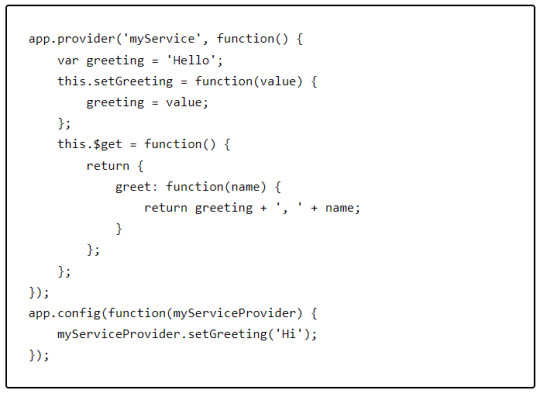
Using Services:
Once a service is created, it can be injected into controllers, directives, or other services.

Why Use AngularJS Services?
Code Reusability: Services promote code reuse by encapsulating logic that can be shared across multiple components.
Separation of Concerns: By using services, you can keep your controllers lean and focused on presentation logic, while business logic resides in services.
Testing: Services are easier to test independently compared to controllers or directives.
Enhance Your Skills with Angular JS Online Training
Understanding and utilizing AngularJS services is crucial for developing efficient and scalable web applications. Our Angular JS Online Training at NareshIT is designed to help you master these concepts and more. Our comprehensive curriculum covers everything from basic to advanced AngularJS topics, ensuring you gain the skills needed to excel in your career.
Join our training program to:
Learn from industry experts.
Gain hands-on experience with real-world projects.
Access flexible online classes to suit your schedule.
youtube
0 notes
Text
The Latest Trends in CI/CD Practices: Boost Your DevOps Skills
In the rapidly evolving world of software development, Continuous Integration and Continuous Deployment (CI/CD) practices are at the forefront of ensuring efficient and reliable software delivery. Staying updated with the latest trends in CI/CD is crucial for anyone pursuing a career in DevOps. In this blog post, we’ll explore the most recent trends in CI/CD practices, helping you enhance your skills through our DevOps Online Training at NareshIT.
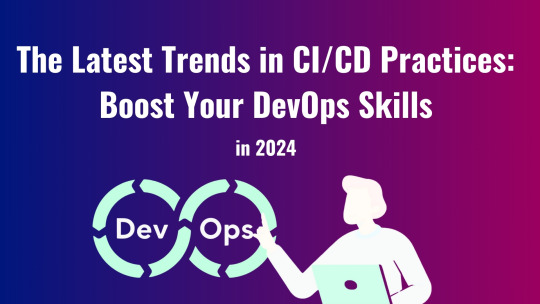
Trend 1: Enhanced Automation
Automation continues to be a cornerstone of CI/CD pipelines. Modern tools are leveraging advanced automation to minimize manual intervention, leading to faster and more reliable deployments. Tools like Jenkins, GitLab CI, and CircleCI are integrating AI to predict potential issues and automate resolutions, making the deployment process smoother than ever.
Trend 2: Shift-Left Testing
Shift-left testing is gaining traction, emphasizing the importance of early and continuous testing throughout the development cycle. By integrating testing earlier in the pipeline, developers can identify and address issues sooner, reducing the risk of bugs reaching production. This approach enhances software quality and accelerates delivery times.
Trend 3: Security Integration (DevSecOps)
Incorporating security into the CI/CD pipeline, known as DevSecOps, is becoming essential. As cyber threats evolve, embedding security practices from the outset ensures that applications are secure by design. Tools like Snyk, Aqua Security, and Twistlock are popular for integrating security scanning into CI/CD workflows.
Trend 4: Microservices and Containers
Microservices architecture and containerization, primarily using Docker and Kubernetes, are revolutionizing CI/CD practices. These technologies enable isolated, scalable, and faster deployments. They also support continuous integration and deployment by allowing developers to work on individual components without affecting the entire system.
Trend 5: Continuous Monitoring and Feedback
Continuous monitoring and feedback loops are crucial for maintaining high standards of performance and user experience. Real-time monitoring tools such as Prometheus, Grafana, and New Relic provide ongoing insights into application performance, enabling prompt identification and resolution of issues.
Trend 6: Infrastructure as Code (IaC)
Infrastructure as Code (IaC) is becoming integral to CI/CD pipelines. Tools like Terraform, Ansible, and Chef allow developers to manage and provision infrastructure through code, ensuring consistency, repeatability, and faster deployments. IaC practices are essential for maintaining scalable and reliable environments.
Trend 7: GitOps
GitOps is a paradigm shift in CI/CD practices, leveraging Git repositories as the source of truth for declarative infrastructure and applications. This approach enhances collaboration, version control, and compliance, making it easier to manage complex deployments. Tools like Argo CD and Flux are leading the charge in GitOps adoption.
Enhance Your Skills with DevOps Online Training
Staying updated with these trends is vital for anyone involved in DevOps. At NareshIT, our DevOps Certification Course Online Training covers all these trends and more. Our comprehensive curriculum is designed to equip you with the latest skills and best practices in CI/CD, ensuring you stay ahead in your career.
Join our DevOps Online Training today and transform your career by mastering the latest CI/CD practices. Our expert trainers and hands-on approach will guide you through the complexities of modern DevOps, making you proficient in the most sought-after skills in the industry.
youtube
Enhance your career prospects by staying updated with the latest trends in CI/CD practices. Enroll in our DevOps Certification Course Online Training and become a DevOps expert today!
0 notes
Text

Discover top-tier DevOps online training in Hyderabad at Naresh IT! Our comprehensive course equips you with the latest tools and methodologies essential for mastering DevOps practices. Learn from industry experts through hands-on projects, live sessions, and interactive modules.
Our DevOps training covers a wide array of topics including version control, continuous integration, continuous deployment, containerization, configuration management, and more. Gain practical insights into popular DevOps tools like Docker, Kubernetes, Jenkins, Ansible, and Git.
Overview:
Learn DevOps methodologies and best practices from industry professionals.
Hands-on experience with real-world projects and scenarios.
Interactive sessions for better understanding and retention.
Access to a supportive learning community and resources.
Who Can Learn:
IT professionals seeking to enhance their skills in DevOps.
Software developers interested in streamlining their development processes.
System administrators aiming to automate infrastructure management.
Anyone passionate about modern software development practices.
Why Choose Naresh IT:
Experienced trainers with extensive industry knowledge.
Flexible online training options to suit your schedule.
Practical, project-based learning approach.
Affordable pricing and value-packed courses.
Placement assistance and career support.
Elevate your career with DevOps expertise from Naresh IT. Enroll now and embark on a journey towards becoming a proficient DevOps practitioner!
0 notes
Text
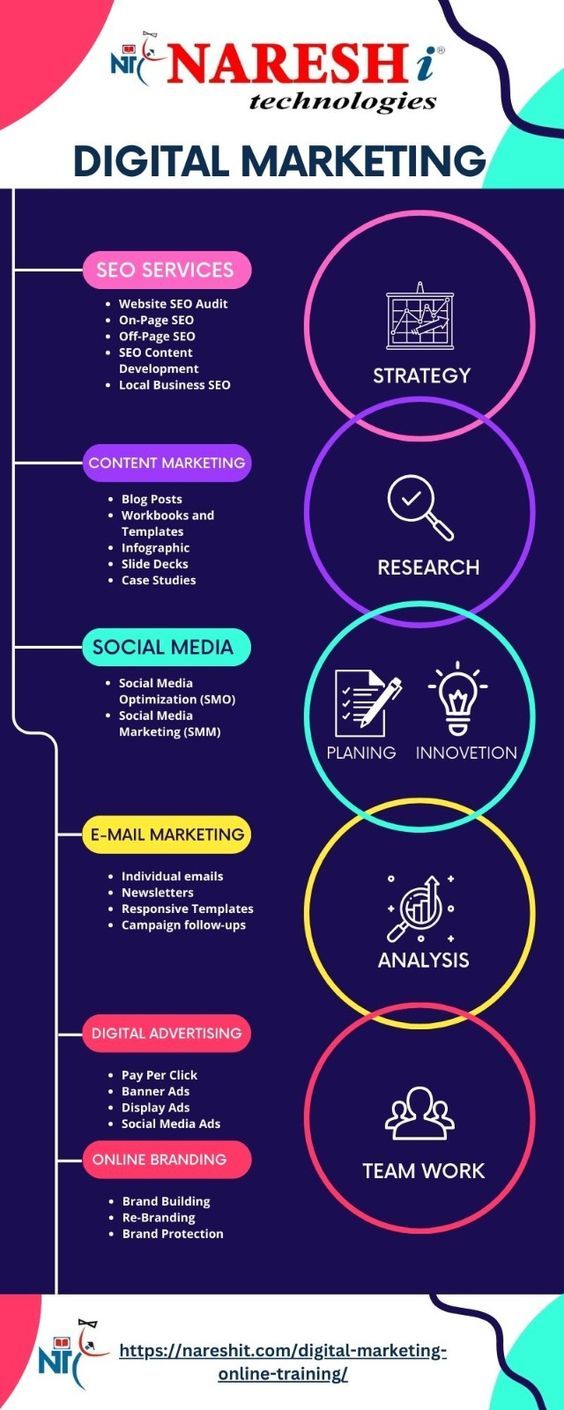
Best Digital Marketing Online Course In India
Digital marketing is an umbrella for an online system. Digital marketing refers to advertising which is delivered through the digital channel. Few digital marketing is like websites, social media, emails and mobile apps. The product is being marketed through digital technology. This Digital marketing online training course will help how to use the Facebook, Twitter, LinkedIn, etc for online advertisement. In simple term, the digital marketing means the promotion of the products or brands via some electronic media.
Attend Free Online Demo On Digital Marketing
For More Details:
Visit: https://nareshit.com/digital-marketing-online-training/
Call: 040-2374 6666 | [email protected]
#DigitalMarketing #OnlineAdvertising #SocialMediaMarketing #SEO #SEM #ContentMarketing #EmailMarketing #InfluencerMarketing #SocialMediaAds #PPC #AffiliateMarketing #VideoMarketing #GoogleAds #FacebookAds #InstagramMarketing #LinkedInMarketing #TwitterMarketing #PinterestMarketing #ContentCreation #MobileMarketing #EmailCampaigns
#digitalmarketing#seo marketing#seo tools#content generation#social marketing#google ads#facebook ads
0 notes
Text
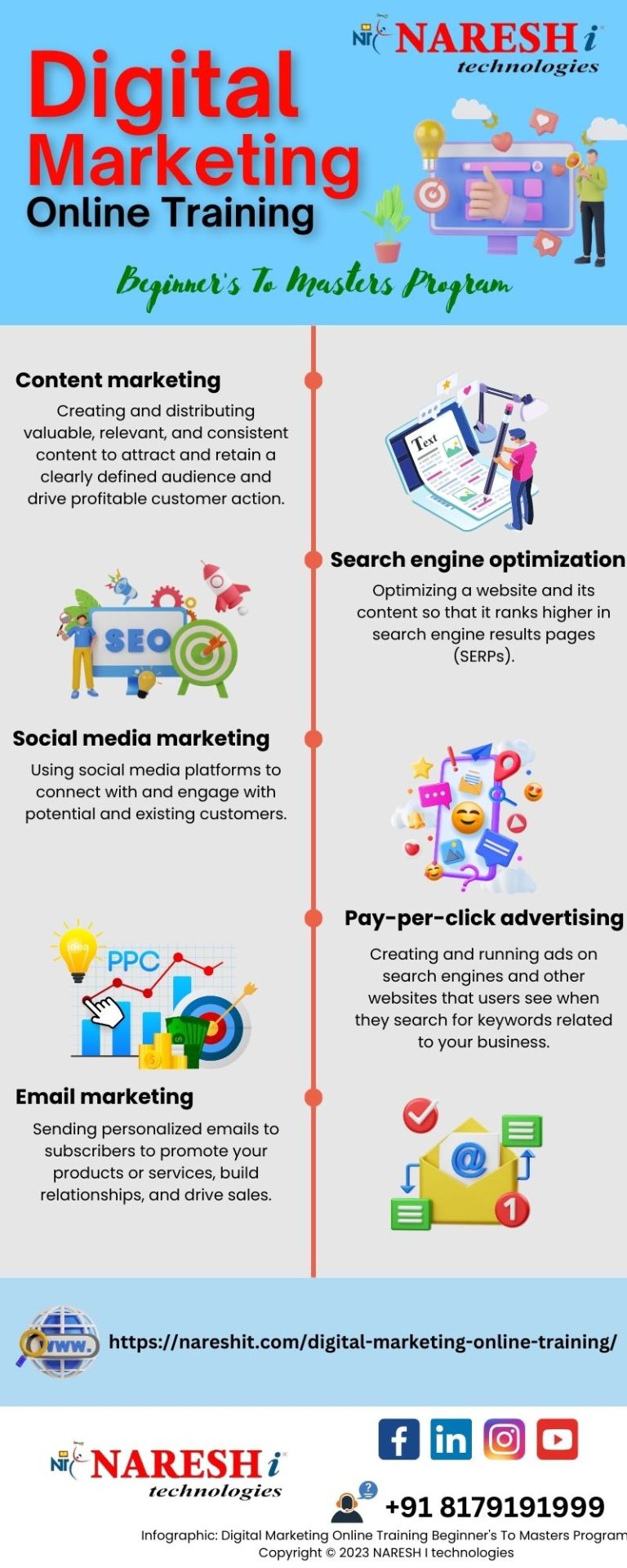
Digital marketing is an umbrella for an online system. Digital marketing refers to advertising which is delivered through the digital channel. Few digital marketing is like websites, social media, emails and mobile apps. The product is being marketed through digital technology. This Digital marketing online training course will help how to use the Facebook, Twitter, LinkedIn, etc for online advertisement. In simple term, the digital marketing means the promotion of the products or brands via some electronic media.
Attend Free Online Demo On Digital Marketing
For More Details:
Visit: https://nareshit.com/digital-marketing-online-training/
Call: 040-2374 6666 | [email protected]
#DigitalMarketing #OnlineAdvertising #SocialMediaMarketing #SEO #SEM #ContentMarketing #EmailMarketing #InfluencerMarketing #SocialMediaAds #PPC #AffiliateMarketing #VideoMarketing #GoogleAds #FacebookAds #InstagramMarketing #LinkedInMarketing #TwitterMarketing #PinterestMarketing #ContentCreation #MobileMarketing #EmailCampaigns
0 notes
Text
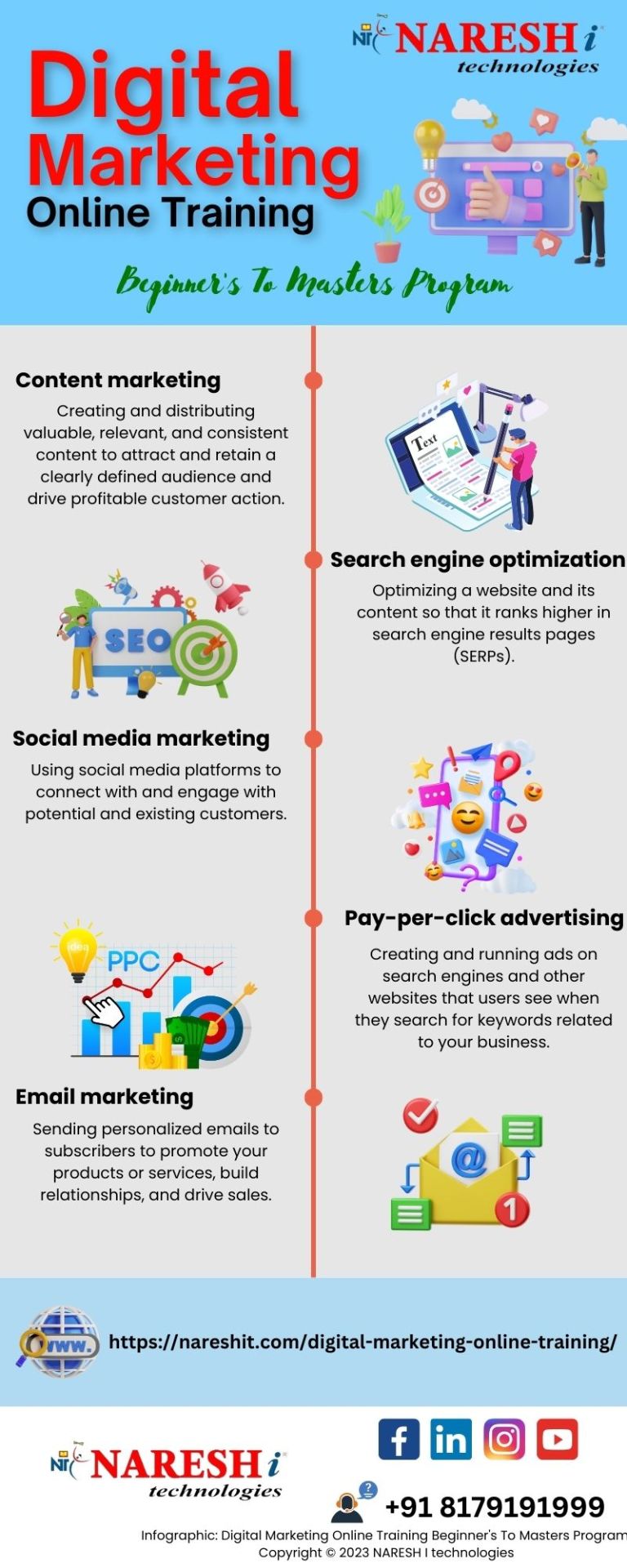
Best Digital Marketing Online Training In Hyderabad
Digital marketing is an umbrella for an online system. Digital marketing refers to advertising which is delivered through the digital channel. Few digital marketing is like websites, social media, emails and mobile apps. The product is being marketed through digital technology. This Digital marketing online training course will help how to use the Facebook, Twitter, LinkedIn, etc for online advertisement. In simple term, the digital marketing means the promotion of the products or brands via some electronic media.
Attend Free Online Demo On Digital Marketing
For More Details:
Visit: https://nareshit.com/digital-marketing-online-training/
Call: 040-2374 6666 | [email protected]
#digitalmarketing#seo marketing#seo tools#content generation#social marketing#google ads#facebook ads
0 notes
Text
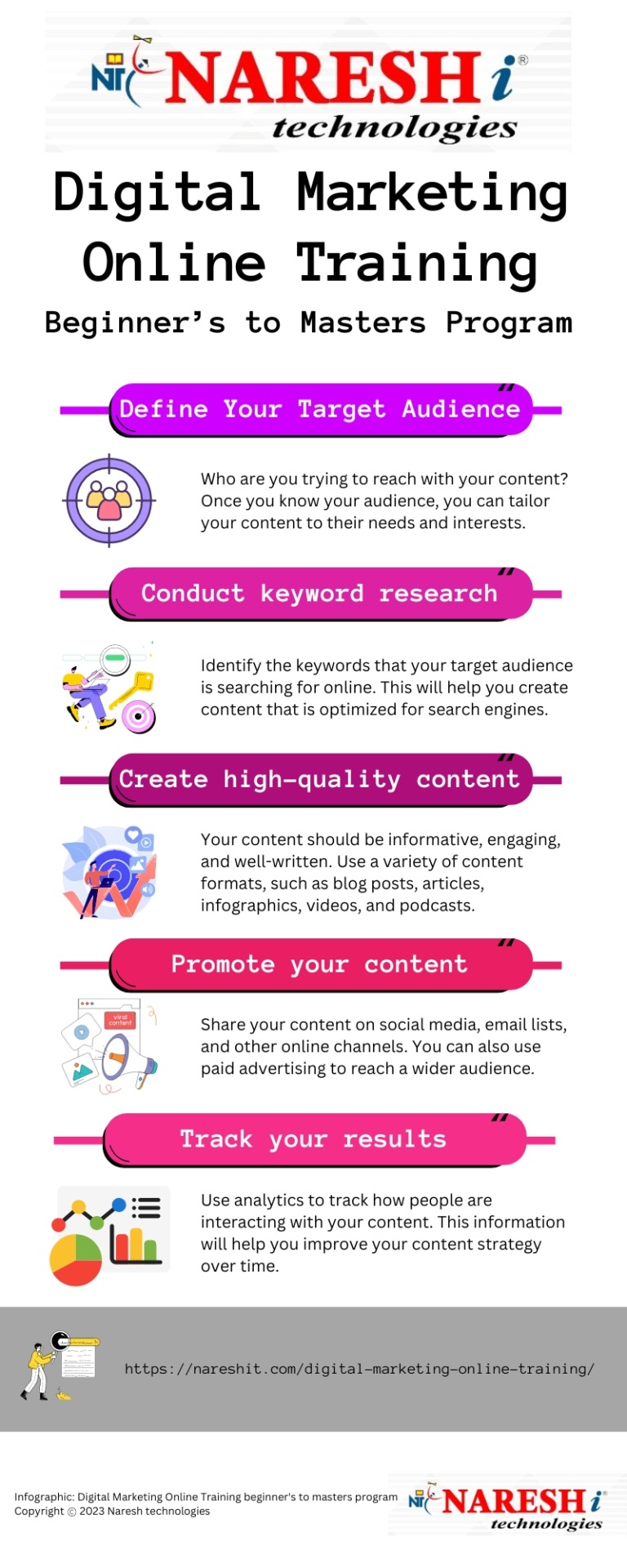
Best Online Digital Marketing Training In Ameerpet
Digital marketing is an umbrella for an online system. Digital marketing refers to advertising which is delivered through the digital channel. Few digital marketing is like websites, social media, emails and mobile apps. The product is being marketed through digital technology. This Digital marketing online training course will help how to use the Facebook, Twitter, LinkedIn, etc for online advertisement. In simple term, the digital marketing means the promotion of the products or brands via some electronic media.
Attend Free Online Demo On Digital Marketing
For More Details:
Visit: https://nareshit.com/digital-marketing-online-training/
Call: 040-2374 6666 | [email protected]
#DigitalMarketing #OnlineAdvertising #SocialMediaMarketing #SEO #SEM #ContentMarketing #EmailMarketing #InfluencerMarketing #SocialMediaAds #PPC #AffiliateMarketing #VideoMarketing #GoogleAds #FacebookAds
#digitalmarketing#seo marketing#seo tools#content generation#social marketing#google ads#facebook ads
0 notes
Text
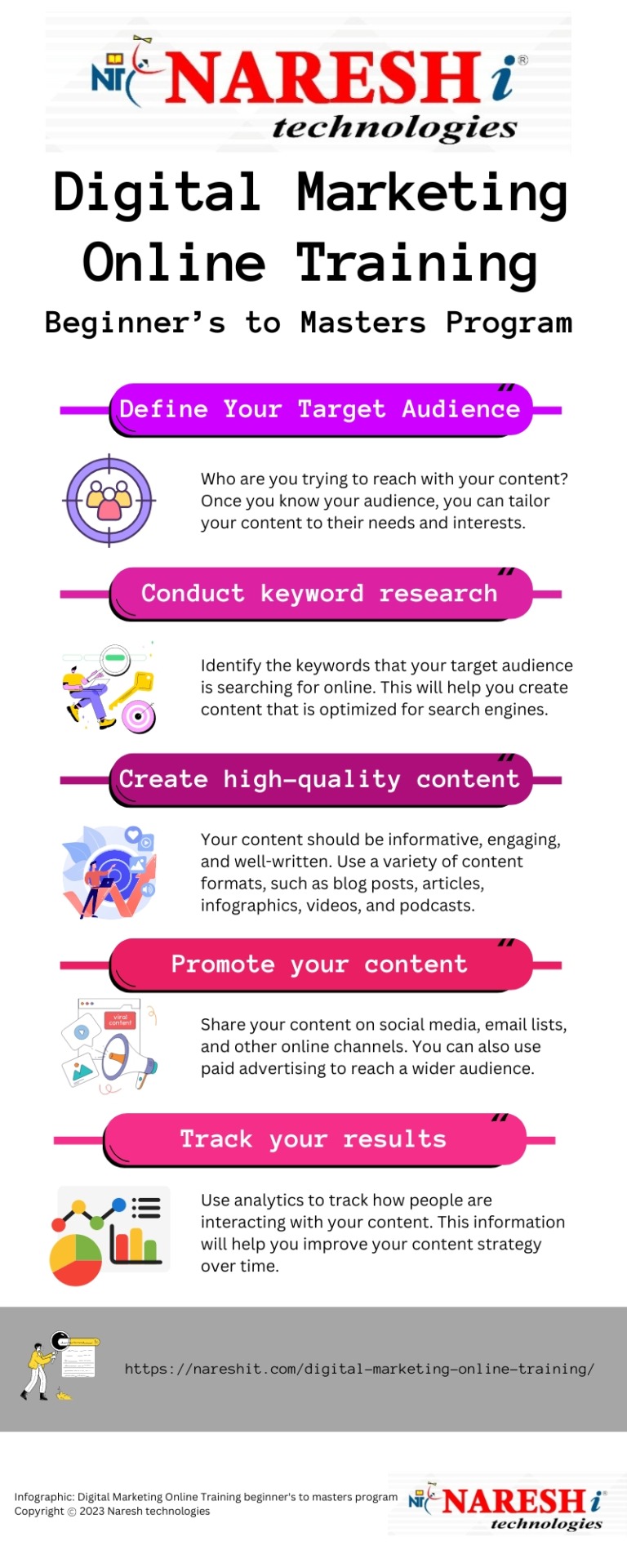
Best Online Digital Marketing Training In India
Digital marketing is an umbrella for an online system. Digital marketing refers to advertising which is delivered through the digital channel. Few digital marketing is like websites, social media, emails and mobile apps. The product is being marketed through digital technology. This Digital marketing online training course will help how to use the Facebook, Twitter, LinkedIn, etc for online advertisement. In simple term, the digital marketing means the promotion of the products or brands via some electronic media.
Attend Free Online Demo On Digital Marketing
For More Details:
Visit: https://nareshit.com/digital-marketing-online-training/
Call: 040-2374 6666 | [email protected]
#digitalmarketing#seo marketing#seo tools#content generation#social marketing#google ads#facebook ads
0 notes
Text

Best Online Digital Marketing Training In Hyderabad
#digitalmarketing#seo marketing#seo tools#content generation#social marketing#google ads#facebook ads
0 notes
Text
Essential Modules for Mastering Digital Marketing Success
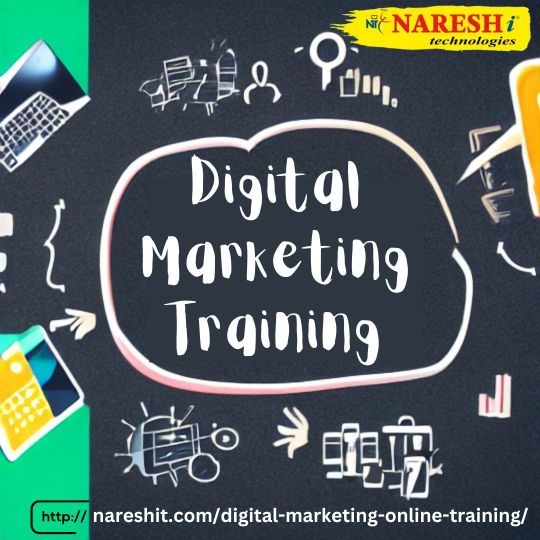
What are the major Modules in Digital Marketing ?
Digital marketing encompasses various modules or components that work together to achieve marketing goals in the online realm. Here are some major modules in digital marketing:
1. Search Engine Optimization (SEO): SEO involves optimizing websites and content to improve their visibility and rankings in search engine results pages. It includes techniques like keyword research, on-page optimization, link building, and technical optimizations to attract organic (non-paid) traffic.
2. Search Engine Marketing (SEM): SEM involves paid advertising on search engines. It typically includes pay-per-click (PPC) campaigns where advertisers bid on keywords to display their ads in search engine results. The most common platform for SEM is Google Ads.
3. Social Media Marketing (SMM): SMM involves leveraging social media platforms like Facebook, Instagram, Twitter, LinkedIn, and others to reach and engage with the target audience. It includes creating and sharing content, running paid ads, and building a community around a brand.
4. Content Marketing: Content marketing focuses on creating and distributing valuable and relevant content to attract and engage a target audience. It includes blog posts, articles, videos, infographics, ebooks, and more. Content marketing aims to educate, entertain, or inspire the audience, ultimately building brand awareness and driving conversions.
5. Email Marketing: Email marketing involves sending targeted emails to prospects or customers to nurture relationships, promote products or services, and drive conversions. It includes building an email list, designing engaging email templates, segmenting the audience, and measuring campaign performance.
6. Influencer Marketing: Influencer marketing involves collaborating with influential individuals or social media personalities to promote products or services. Brands partner with influencers who have a significant following and influence over their audience to tap into their reach and credibility.
7. Affiliate Marketing: Affiliate marketing is a performance-based marketing model where affiliates earn a commission for promoting a brand's products or services. Affiliates drive traffic or sales through their unique tracking links or promotional efforts, and they receive a commission for each successful referral or sale.
8. Online PR and Reputation Management: Online PR focuses on managing a brand's reputation and public image through various online channels. It involves monitoring online mentions, addressing customer feedback or complaints, and building positive relationships with online influencers or media outlets.
9. Conversion Rate Optimization (CRO): CRO aims to improve the percentage of website visitors who take desired actions, such as making a purchase or filling out a form. It involves analyzing user behavior, conducting A/B testing, and optimizing landing pages, forms, and user flows to maximize conversions.
10. Analytics and Data-driven Marketing: This module involves tracking and analyzing data to gain insights into marketing performance. It includes using tools like Google Analytics to measure website traffic, user behavior, and conversions. Data-driven marketing helps make informed decisions and optimize marketing strategies.
These modules often overlap and complement each other, forming a comprehensive digital marketing strategy tailored to specific business objectives and target audiences.
Click Then For Digital Marketing Online Training :
#digitalmarketing#seo marketing#seo tools#content generation#social marketing#google ads#facebook ads
0 notes